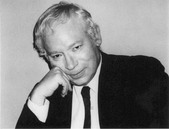 I don't like Steven Weinberg.
I don't like Steven Weinberg.Good, I have said it.
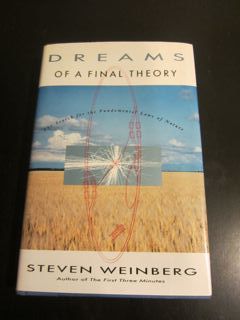 I will provide a brief biographical sketch and a short list of his lengthy accomplishments. I read one of his science outreach books, "Dreams of a Final Theory: The Search for the Fundamental Law of Nature". I will pluck out three issues from the book to show why our scientific beliefs are divergent.
I will provide a brief biographical sketch and a short list of his lengthy accomplishments. I read one of his science outreach books, "Dreams of a Final Theory: The Search for the Fundamental Law of Nature". I will pluck out three issues from the book to show why our scientific beliefs are divergent.Steve-o went to the Bronx High School of Science. That school's reputation towers above all others in the nation, public or private. The school is a magnet pulling from the vast pool of scrappy New York City kids.
Click or skip this reading of the blog:
Stevie skipped through the elite tiers of higher ed: Cornell, the Neils Bohr Institute in Copenhagen, Princeton, Berkeley, Columbia, Harvard, a year visiting at MIT, and the University of Texas at Austin. The last stint was located close to the filled in hole in the ground known as the Superconducting Super Collider.
Steve is the third most creative physicist on the planet according to one study. He shared the 1979 Nobel Prize with his high school classmate, Sheldon "I-don't-care-what-SU(2)-looks-like" Glashow. The third scholar to share the prize was Mohammad Abdus Salam, who is Pakistani and grew up far away from the Bronx.
 Sir Steven is exceedingly exceptional at mathematics. He finds math errors in other people's papers. If his skill had been spelling, he would correct the dictionary. His justified self-confidence is why I call him Alf, which stands for Arrogant F---. Someone might point out that the "l" in the acronym stands for nothing. It is there just to piss him off.
Sir Steven is exceedingly exceptional at mathematics. He finds math errors in other people's papers. If his skill had been spelling, he would correct the dictionary. His justified self-confidence is why I call him Alf, which stands for Arrogant F---. Someone might point out that the "l" in the acronym stands for nothing. It is there just to piss him off.Alf is measurably smarter than I am. I know that, he knows that. Actually, he doesn't know that. The ultra-conservative fringe physicists like me is not on his radar. I am confident if he were to get to know me, he would not like me either. I am sloppy with technical jargon to a fault. Having not lived in the halls of elite institutions, I mispronounce names. I use math errors as an exploratory process. Pictures are central to my world view, a feature absent in much of his work.
Alf was a booster for the SSC. The book "Dreams of a Final Theory" was part of the failed promotion process for the collider. I read books with pen in hand to underline parts I like and to provide a way back to revisit those fun insights. This was the first and only book I felt I needed to read with a red pen in hand so I could mark where I disagreed with the author. Every few pages there are notes scribbled in the margins. If he said it, I found a way to disagree.
I recall gripping my red pen and wondering why I was so angry at Alf? Science is a collection of theories well-supported by experimental data. We didn't have any issues with the theories or the scientific process. Where we differed is what I call scientific beliefs: these are the implications beyond the scope of the theory itself, beliefs that create views of meaning in the Universe. I now appreciate why scientists can totally not stand each other: it is less the science, and more the extension and implications of the work that leads to animated disagreements. That lesson was worth the red ink. I have chosen three margin notes for this blog.
DNA&Quantum Mechanics
When physicists start talking about DNA, it is time to defend my turf. Here were his comments about the double helix:
Page 32:
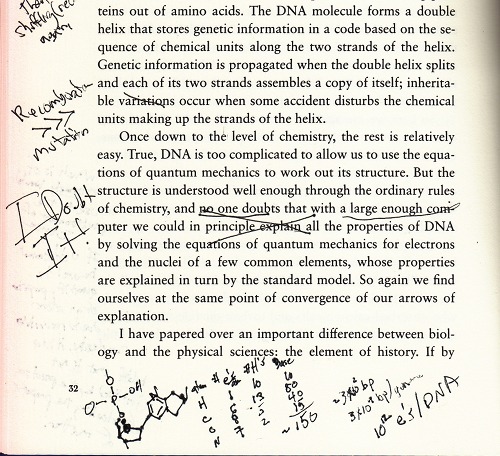
I will not go into my sex is more important than mutations riff which was the subject of a recent blog. Just because I am sloppy in physics doesn't mean I am sloppy in biology. Actually, it does mean that because I use the same hardware. The base I wrote in the margin is in error. The ribose sugar connects to a nitrogen in the 5 member ring not the 6 member ring. The point of the imprecise sketch was to get an estimate for the number of electrons in one of our chromosomal sets of DNA. Accord to my margin note, it is on the order of 1012 electrons. There are the protons and neutrons to account for also.
Here is where Alf and I agree: There are laws of quantum mechanics that can be solved exactly for the hydrogen atom. Those same laws can be solved approximately for helium. As we go to more complex atoms and molecules, the calculations become more daunting. The agreement at this point is spot on.
Now we do a stretch, to a large enough computer. I think we both agree such a machine is not going to be built ever. This is where our beliefs differ. He imagines that the take home message is that the standard model is at the root of it all. My belief is that when a calculation becomes this all-consuming, Nature herself does not operate this way, that a new logic is born out of massive recursion. There will be a few, isolated simple systems where Schrödinger's equation will come into play, but in general, the standard model is irrelevant to a description of how DNA works.
Definitions of Beauty, Love, and Fear
Alf decides to dodge definitions of beauty, love, or fear.
Page 134:
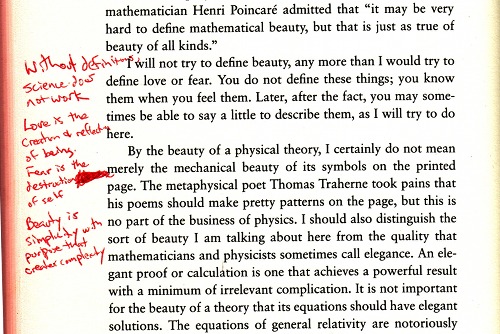
That struck me as a cop out. Definitions are the starting point for science. It doesn't matter if the definition is universally accepted. It does matter that you have a precise one, to keep the discussion focused. Here are my three definitions.
Beauty is simplicity with purpose that creates complexity. I like the tension between simplicity and complexity that gets mitigated by purpose. Here is a clay sculpture I did called "Beth":
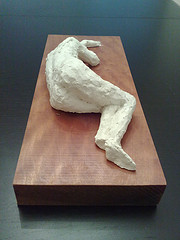
It is a simple nude. I remember looking at the skin on her back move against her ribs. I was disappointed that I was not going to be able to represent that aspect of her form, too complicated for clay. She was, and will remain for me, a beautiful representation of my species.
Love is the creation and reflection of being. That covers both making love, and the look between mother and child. It also excludes rocks loving water. Sure, the two interact, but no love is involved.
Fear is the destruction of self. Threats to self get me to run. When I got mugged, one question on my mind was about weapons - take my stuff, but I sure hope no one has a gun. Thank goodness no one in the tense interaction had exercised their second amendment rights to keep and bear arms as part of a well regulated militia (the NRA should point out regulation is part of the second amendment, no?). I had read articles on model mugging, a program that teaches women how to deal with such situations. One approach is to scream loudly. That was the technique I used: absolute, full volume shout out of the story of what was going on at the moment: "They took my bag, with my glucose meter and I am a diabetic..." When I saw the three run one way, I turned and went the other direction. It took a while to calm down, but the self was all there, and I even got the bag back. I guess my monologue created fear of being caught for them.
Rereading the passage from the book, I noticed his comments about general relativity:
It is not important for the beauty of a theory that its equations should have elegant solutions. The equations of general relativity are notoriously difficult to solve except in the simplest situations, but this does not detract from the beauty of the theory itself.
Half of general relativity is beautiful, the pure geometry. The stress-energy tensor is clucky. The simplest, static solution is much uglier than it is usually marketed. The Minkowski metric for empty spacetime is simple with the purpose of preserving the spacetime interval. That does lead to something complicated: all the detailed observations of special relativity. Take the first baby step away from empty spacetime in isotropic coordinates, and here is what the Schwarzshild metric looks like:
I always have to look this up in Misner, Thorne, and Wheeler, hidden in a question at the end of a chapter (p. 840, exercise 31.7). For me, this solution does detract from the beauty of general relativity. A final theory should have manifestly beautiful equations and solutions. Here is a claim I made about my unification equations in my second blog here:
I will stand next to this strong statement: the derivation and field equations for the GEM unified standard model proposal are drop dead gorgeous. That claim already applies as is to the Maxwell equations, which are stunning. I am inviting a few more beauties to the party.How about the solutions? One of them is comic. The solution to the first GEM field equation would have been known by Pierre Simon Laplace:
Most of this stuff was fresh for the Frenchman. Ben Franklin did his experiments in the mid 1700's. Henry Cavendish determine the value of G in 1798. http://en.wikipedia.org/wiki/Cavendish_experiment Planck's constant would have to wait. Still, Laplace could solve the equation that bears his name today. Take Newton's force for gravity written as a potential and subtract Gauss's law in potential form. Get the B as in Bingo.
Here are the other three GEM field equations:
Snarky puzzle: find the answers to these three equations. Look to
To my eye, the solutions are beautiful, nice variations on a 1/R potential. One up on general relativity. I don't get to say that everyday :-)
The Future of Quantum Mechanics
Alf is sure not much can change for quantum mechanics.
Page 88-89
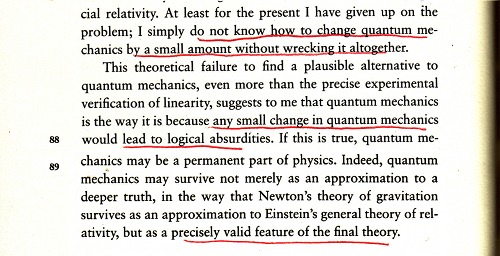
This guy is measurably more creative in physics than nearly everyone else. Does he have a blind side? My guess is that visually, he is [not as skilled as he should be (correction in tone for too harsh a word choice)]. There was not a single image in the book. It is common for people to get Ph.D.'s and not be able to draw. This is a horrible waste of mental resources. The back of the brain will not be able to do anything but think visually.
People can learn to think visually at any age. Please note I did not say draw. It is a common misconception that this is a hand thing. I highly recommend "Drawing on the Right Side of the Brain" by Betty Edwards This is how to engage the back of your brain to see what is there. While it may have been true that visual thinking was not important in Alf's time in quantum field theory, I think the future will demand a visualization of every equation in graduate level quantum field theory books. That would be a huge change - one could even share results with people not versed in the arcane arts of differential calculus (I do show my wife a few of the animations my work generates). The next generation of animated books would have to be computer based.
Much change to look forward to, unless you buy into Alf's view.
I do value my negative pseudo-relationship with Weinberg. The disagreements drove me to think, and thinking is good. Thanks Steven, all the best.
Doug
Snarky puzzle, see above.
Google+ hangout: 11:00-11:45pm Eastern time, Tuesday-Friday. http://gplus.to/sweetser
This could be an efficient way to exchange a few ideas. Note: one person has hung out in a month, and it was a good discussion.
Bet against the Higgs being found, buy the t-shirt
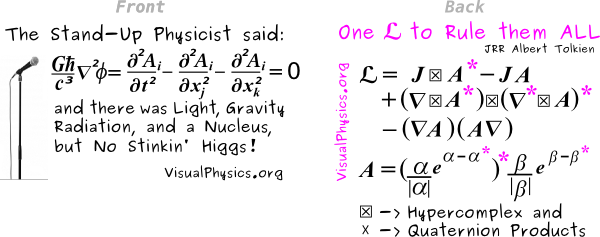
Next Monday/Tuesday: Weekly Science 2.0 Blog #26 - Workflow + Data



Comments